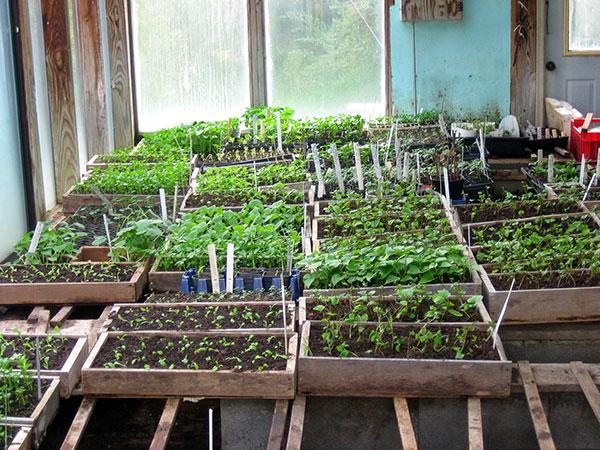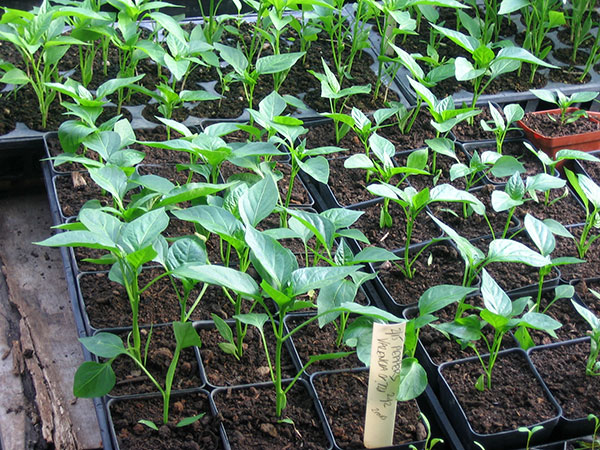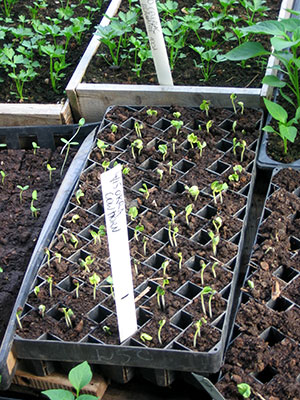Our neighbor Pam Dawling, a contributing writer at Growing for Market, has just released her first book: Sustainable Market Farming: Intensive Vegetable Production on a Few Acres. Pam has been gardening here in the Southeast for many years, and we’re delighted to have this resource, with so much wisdom relevant to our bio-region. We’ve asked Pam to contribute to our blog, and we hope you’ll enjoy reading about her gardens. Pam blogs at sustainablemarketfarming.com/news.
Starting Seedlings, by Pam Dawling
We’ve been starting seedlings since late January, and the greenhouse is filling up with flats of lettuce, cabbage, kohlrabi, spinach, scallions, and broccoli. We’re eating our way through the lettuces that grew overwinter in the compost in the block-work greenhouse beds, and shoveling out the compost to fill our flats. All our seedlings are grown in 100% home-made compost. We screen compost to fill the beds in September and transplant lettuce there in October. When we need the compost for the seedlings, it has mellowed nicely and has plenty of worms. This beats buying in bags of compost, or chipping lumps off a heap of frozen compost outdoors in January!

Our greenhouse has a masonry north wall and a patio-door south wall. It has no heating apart from the sun (this is Zone 7). This space is warm enough and just big enough for all our seedlings once they have emerged. For growing-on the very early tomatoes and peppers, destined for our hoophouse, we use an electric heat mat and a plastic low tunnel in one corner of the greenhouse.
Many seeds benefit from some heat during germination and are then moved into slightly less warm conditions to continue growing. This means it’s possible to heat a relatively small space just to germinate the seeds in. We use two broken refrigerators as insulated cabinets, with extra shelves added. A single incandescent lightbulb in each supplies both the light and the heat (we change the wattage depending on what temperature we’re aiming for). Some people construct an insulated cabinet from scratch, with fluorescent lights suspended above the flats.

We use traditional coldframes for“hardening-off”our plants (helping them adjust to cooler, brighter, breezier conditions). They are rectangles of dry-stacked cinder blocks, with lids of woodframed fiberglass. Having heavy flats of plants at ground level is less than ideal for anyone over thirty-five! Shade houses and single-layer poly hoop structures with ventable sidewalls and benches for the flats are a nicer option. Some growers report that some pests are less trouble when flats are up on benches. Others say flats on the ground produce better quality plants. According to the nighttime temperatures, we cover the coldframes with rowcover for 32°F–38°F (0°–3°C), add the lids for 15°F–32°F (–9°C–0°C) and roll quilts on top if it might go below 15°F (–9°C).

For brassicas, lettuce and our paste tomatoes (a big planting), we use open flats — simple wooden boxes. The transplant flat size is 12" × 24" × 4" deep (30 × 60 × 10 cm). It holds 40 plants, “spotted” or pricked out in a hexagonal pattern, using a dibble board. For sowing, we use shallower 3" (7.5 cm) flats. Usually we sow four rows lengthwise in each seedling flat. We reckon we can get about six transplant flats from each seedling flat. This allows for throwing out any wimpy seedlings, and lets us start a higher number of plants in a smaller space.
Because we transplant by hand, and because we hate to throw plastic away (or spend money when we don’t need to), we use a range of plastic plant containers. For crops where we are growing only a small number of plants of each variety, we use six- or nine-packs, or a plug flat divided into smaller units.

The first crops sown are not necessarily the first ones planted out. Our spinach gets sown Jan 24 and transplanted out 4 weeks later. The early tomatoes get planted in the hoophouse at 6 weeks of age (slower-growing peppers go in at 7.5 weeks with rowcover at the ready!). Lettuce goes outdoors after 6.5 weeks, cabbage after 7.5 weeks, cipollini mini-onions after 8 weeks. These are early season timings and as the days warm up and get longer, seedlings grow more quickly. Being a few days later sowing something in early spring makes little difference, as later sowings can catch up by growing faster in the warmer weather.
If the spring is cold and late, you may find your greenhouse packed to the gills with flats you don’t want to take outside. We try to put the faster-maturing crops near the doors and keep the open flats, which will need spotting-out, near the accessible north side.
But let’s not complain about the bounty of so many plants! Spring is an exciting time of year, full of new growth and new potential. Working in the greenhouse with tiny plants on a sunny day when it’s cold outside is a special treat.
